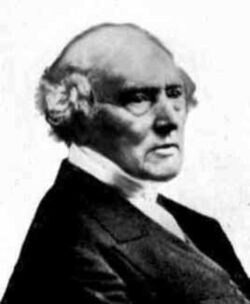Biography:Thomas Kirkman
Thomas Penyngton Kirkman | |
|---|---|
 | |
| Born | Bolton, Lancashire, England |
| Died | 3 February 1895 (aged 88) Bowdon near Manchester, England |
| Occupation | Mathematician, Minister |
| Known for | Kirkman's schoolgirl problem |
Thomas Penyngton Kirkman FRS (31 March 1806 – 3 February 1895) was a British mathematician and ordained minister of the Church of England. Despite being primarily a churchman, he maintained an active interest in research-level mathematics, and was listed by Alexander Macfarlane as one of ten leading 19th-century British mathematicians.[1][2][3] In the 1840s, he obtained an existence theorem for Steiner triple systems that founded the field of combinatorial design theory, while the related Kirkman's schoolgirl problem is named after him.Cite error: Closing </ref> missing for <ref> tag
Generalizing the quaternions and octonions, Kirkman called a pluquaternion Qa a representative of a system with a imaginary units, a > 3.
Kirkman's paper was dedicated to confirming Cayley's assertions concerning two equations among triple-products of units as sufficient to determine the system in case a = 3 but not a = 4.[4] By 1900 these number systems were called hypercomplex numbers, and later treated as part of the theory of associative algebras.
Polyhedral combinatorics
Beginning in 1853, Kirkman began working on combinatorial enumeration problems concerning polyhedra, beginning with a proof of Euler's formula and concentrating on simple polyhedra (the polyhedra in which each vertex has three incident edges). He also studied Hamiltonian cycles in polyhedra, and provided an example of a polyhedron with no Hamiltonian cycle, prior to the work of William Rowan Hamilton on the Icosian game. He enumerated cubic Halin graphs, over a century before the work of Halin on these graphs.[5] He showed that every polyhedron can be generated from a pyramid by face-splitting and vertex-splitting operations, and he studied self-dual polyhedra.[1][3]
Late work
Kirkman was inspired to work in group theory by a prize offered beginning in 1858 (but in the end never awarded) by the French Academy of Sciences. His contributions in this area include an enumeration of the transitive group actions on sets of up to ten elements. However, as with much of his work on polyhedra, Kirkman's work in this area was weighed down by newly invented terminology and, perhaps because of this, did not significantly influence later researchers.[1][3]
In the early 1860s, Kirkman fell out with the mathematical establishment and in particular with Arthur Cayley and James Joseph Sylvester, over the poor reception of his works on polyhedra and groups and over issues of priority. Much of his later mathematical work was published (often in doggerel) in the problem section of the Educational Times and in the obscure Proceedings of the Literary and Philosophical Society of Liverpool.[1] However, in 1884 he began serious work on knot theory, and with Peter Guthrie Tait published an enumeration of the knots with up to ten crossings.[3] He remained active in mathematics even after retirement, until his death in 1895.[3]
Awards and honours
In 1857, Kirkman was elected as a fellow of the Royal Society for his research on pluquaternions and partitions.[1] He was also an honorary member of the Literary and Philosophical Society of Manchester and the Literary and Philosophical Society of Liverpool, and a foreign member of the Dutch Society of Science.[2]
Since 1994, the Institute of Combinatorics and its Applications has handed out an annual Kirkman medal, named after Kirkman, to recognise outstanding combinatorial research by a mathematician within four years of receiving a doctorate.
Notes
- ↑ 1.0 1.1 1.2 1.3 1.4 "T. P. Kirkman, mathematician", The Bulletin of the London Mathematical Society 13 (2): 97–120, 1981, doi:10.1112/blms/13.2.97.
- ↑ 2.0 2.1 Lectures on Ten British Mathematicians of the Nineteenth Century, New York: John Wiley & Sons, Inc., 1916, https://www.gutenberg.org/ebooks/9942.
- ↑ 3.0 3.1 3.2 3.3 3.4 O'Connor, John J.; Robertson, Edmund F. (1996), "Thomas Penyngton Kirkman", MacTutor History of Mathematics archive, University of St Andrews, http://www-history.mcs.st-andrews.ac.uk/Biographies/Kirkman.html.
- ↑ A. J. Crilly (2006) Arthur Cayley: Mathematician Laureate of the Victorian Era, Johns Hopkins University Press, p. 143 on Kirkman's collaboration with Cayley
- ↑ Kirkman, Th. P. (1856), "On the enumeration of x-edra having triedral summits and an (x − 1)-gonal base", Philosophical Transactions of the Royal Society of London: 399–411, doi:10.1098/rstl.1856.0018.
 |

